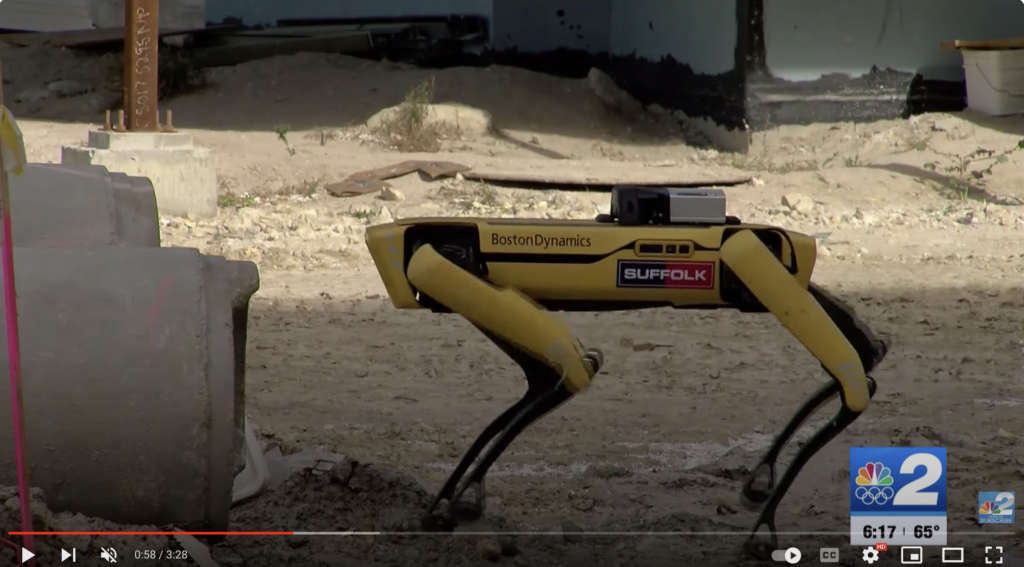The construction industry is undergoing significant technological change, and advanced robotics are now playing an increasingly prominent role in streamlining operations and improving efficiency. Among these cutting-edge innovations are robotic dogs, such as Boston Dynamics‘ Spot, which are currently being deployed on construction sites worldwide for a variety of tasks, including data mapping.

Why use robotic dogs for construction?
Robotic dogs are equipped with a sophisticated array of sensors, cameras, and other data collection devices that enable them to autonomously navigate complex construction environments. Their agile mobility allows them to traverse rough terrain, climb stairs, and access hard-to-reach areas, providing unparalleled flexibility in data collection.
Robotic dogs and data mapping
One of the primary applications of robotic dogs is data mapping and surveying. These robots can capture detailed information about the construction site from various angles and perspectives, generating comprehensive datasets that are invaluable to teams. By collecting data on factors such as topography, structural integrity, equipment placement, and environmental conditions, robotic dogs provide companies with critical insights for planning, monitoring progress, ensuring quality, and enhancing safety.
Key advantages of robotic dogs
One of the key advantages of using robotic dogs for data mapping is their ability to operate autonomously, minimising human intervention in potentially hazardous or challenging environments. This not only improves efficiency but also enhances safety by mitigating the risk of injury to workers.
Furthermore, robotic dogs offer precise accuracy and reliability in data collection, thanks to their advanced sensors and navigation capabilities. Unlike traditional surveying methods, which may be limited by factors such as human error or equipment constraints, robotic dogs can consistently capture high-quality data with exceptional detail and consistency.
How can the data be used?
The data collected by robotic dogs can be utilised for a wide range of purposes throughout the construction process. For instance, during site establishment planning this data can be used to optimise layout and logistics, architects can incorporate it into design considerations, project managers can monitor progress and identify potential issues, and safety professionals can assess risks and implement mitigation measures.
In the ‘Spot’-light – Suffolk Construction robotic dog case study
Suffolk Construction, a major construction management firm based in the United States, has been utilising Spot, the robotic dog developed by Boston Dynamics, on its sites. Suffolk has been at the forefront of adopting innovative technologies to improve efficiency, safety, and productivity in its projects.
Spot has been deployed by Suffolk Construction for various tasks, including:
- Data Collection and Mapping: Spot is equipped with cameras and sensors that allow it to capture and analyse data onsite. It can navigate through complex environments and collect valuable information that helps project teams monitor progress, identify potential issues, and make data-driven decisions.
- Safety Inspections: Spot can be deployed to conduct safety inspections in hazardous or hard-to-reach areas of construction sites. Its ability to navigate uneven terrain and tight spaces makes it well-suited for inspecting areas that may be difficult or dangerous for human workers to access.
- Monitoring Construction Progress: Spot can be programmed to autonomously patrol construction sites and capture real-time video footage and images. This data can be used to monitor construction progress, identify bottlenecks, and track the movement of materials and equipment.
- Remote Site Monitoring: Spot’s cameras and sensors can provide live video feeds and data streams that allow project managers and stakeholders to remotely monitor construction sites from anywhere with an internet connection. This capability is especially valuable for large-scale projects or projects located in remote areas.
Suffolk Construction has shown that by using the robotic dog they have streamlined operations, reduced risks, and delivered on projects more effectively. Watch the video to see Spot in action.
(Video source: NBC2News)
Will robotic dogs cost construction workers their jobs?
The integration of robotic dogs in construction is more about augmenting existing tasks than replacing jobs. While they streamline data collection and analysis processes, they also create new opportunities for workers to specialise in robotics maintenance, operation, and oversight. Overall, their impact on job displacement is minimal, and they often enhance efficiency and safety onsite.
Onsite safety
Enhanced safety can occur in several ways:
- Hazard Detection: Equipped with sensors and cameras, robotic dogs can identify potential hazards such as debris, obstacles, or uneven terrain. They can detect safety risks in real-time and alert workers or supervisors, helping prevent accidents.
- Remote Inspection: Robotic dogs can access hard-to-reach areas of construction sites without exposing human workers to risks. They can inspect structures, equipment, or confined spaces, reducing the need for workers to enter dangerous environments.
- Environmental Monitoring: Some robotic dogs are equipped with environmental sensors that can detect changes in temperature, humidity, air quality, or gas levels. By monitoring environmental conditions, they help ensure that workers are not exposed to unsafe working conditions.
- Surveillance: Robotic dogs can patrol construction sites autonomously or under remote control, providing continuous surveillance and monitoring. They can detect unauthorised access, intrusions, or security breaches, enhancing overall site security.
- Emergency Response: In the event of an accident or emergency, robotic dogs can quickly navigate the site to assess the situation and provide real-time data to emergency responders. Their ability to access areas that may be unsafe for humans can facilitate faster response times and more effective emergency management.
How much does Spot cost?
The cost of the robotic dog developed by Boston Dynamics can vary depending on the specific configuration and additional features required. However, reports suggest that Spot’s base price starts at around $74,500. This price may increase with added accessories, software packages, or customisation options chosen by the buyer. Additionally, there may be additional costs for maintenance, support, and training services provided by Boston Dynamics or authorised resellers.
Looking ahead
The use of robotic dogs for data mapping on construction sites is poised to continue expanding as technology evolves and becomes more accessible. As construction companies increasingly recognise the benefits of automation and data-driven decision-making, robotic dogs are likely to become indispensable tools for improving efficiency, productivity, and safety in the construction industry.
Looking for your next construction job? Search our current construction roles here, or to chat with our team about securing your next opportunity, get in contact with us through our Contact Us page.
Receive our updates straight to your inbox





